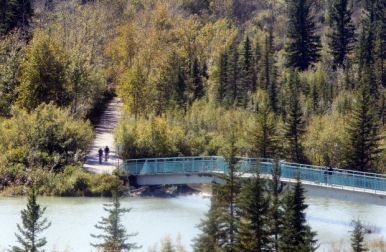
Paul Finkleman describes the Weaselhead as a gem, a giant classroom and one of North America’s most pristine and diverse urban natural areas.
He’s watched a calf moose nurse from its mother in the 404-hectare natural habitat that borders the Glenmore reservoir, and he’s spent countless hours cycling on the parks many pathways while admiring diverse plant life.
The environmental impacts of the southwest ring road deal are concerning to Finkleman and others who, like him, rely on the Weaselhead for an authentic experience with nature in the city.
After decades of negotiations a ring road deal was reached on Thursday and when built, the massive freeway will go through what is now Tsuu T’ina Nation land and run along the west side of Weaselhead.
“There’s not a world class natural area, which the Weaselhead is, that I know of that’s right adjacent to an eight or 16-lane freeway,” said Stephen Herrero, an emeritus professor in the faculty of environmental design at the University of Calgary.
Both Herrero and Finkleman, who is the president of the Weaselhead/Glenmore Park Preservation Society, expressed sadness at the historic ring road deal.
As avid park users, they worry that the massive project will negatively impact the urban oasis and its wildlife and biodiversity.
“Should everything happen as planned, it’s going to have a remarkably negative effect on the Weaselhead and our children will not be able to enjoy what we have now .... It’s a very special spot and it’s going to be altered negatively forever,” Finkleman said.
The list of animals that have been spotted in the natural area is long and includes everything from birds like owls and woodpeckers, to beavers, muskrats, deer, moose and even bears.
If movement corridors for wildlife aren’t executed properly when the new freeway is constructed, Herrero said the park will become an “isolated island” with just a fraction of the animals and natural riches it currently boasts.
The Weaselhead area contains steep escarpments, floodplains and a delta, and is a hub of environmental education for thousands of Calgary students.
The constant sound and light pollution that will come with a bustling road which will be open 24/7 will disturb the area’s species, many of whom are nocturnal, Finkleman said.
He believes the ring road deal “makes a mockery” of the Durban Commitment, a document the City of Calgary has signed that acknowledges the significance and role of local governments in protecting biodiversity.
Herrero, who takes pleasure in listening to songbirds in the park, said it will be possible to buffer the future freeway’s sound, but it will be an expensive process. He believes the massive construction project will need extreme mitigation to protect the area’s diverse ecosystem.
“I intend to work as hard as I can to see that every effort is made to maintain a vital, vibrant, attractive, natural area,” the biologist said.
To view the full article by Annalise Klingbeil in the Calgary Herald, click here.

